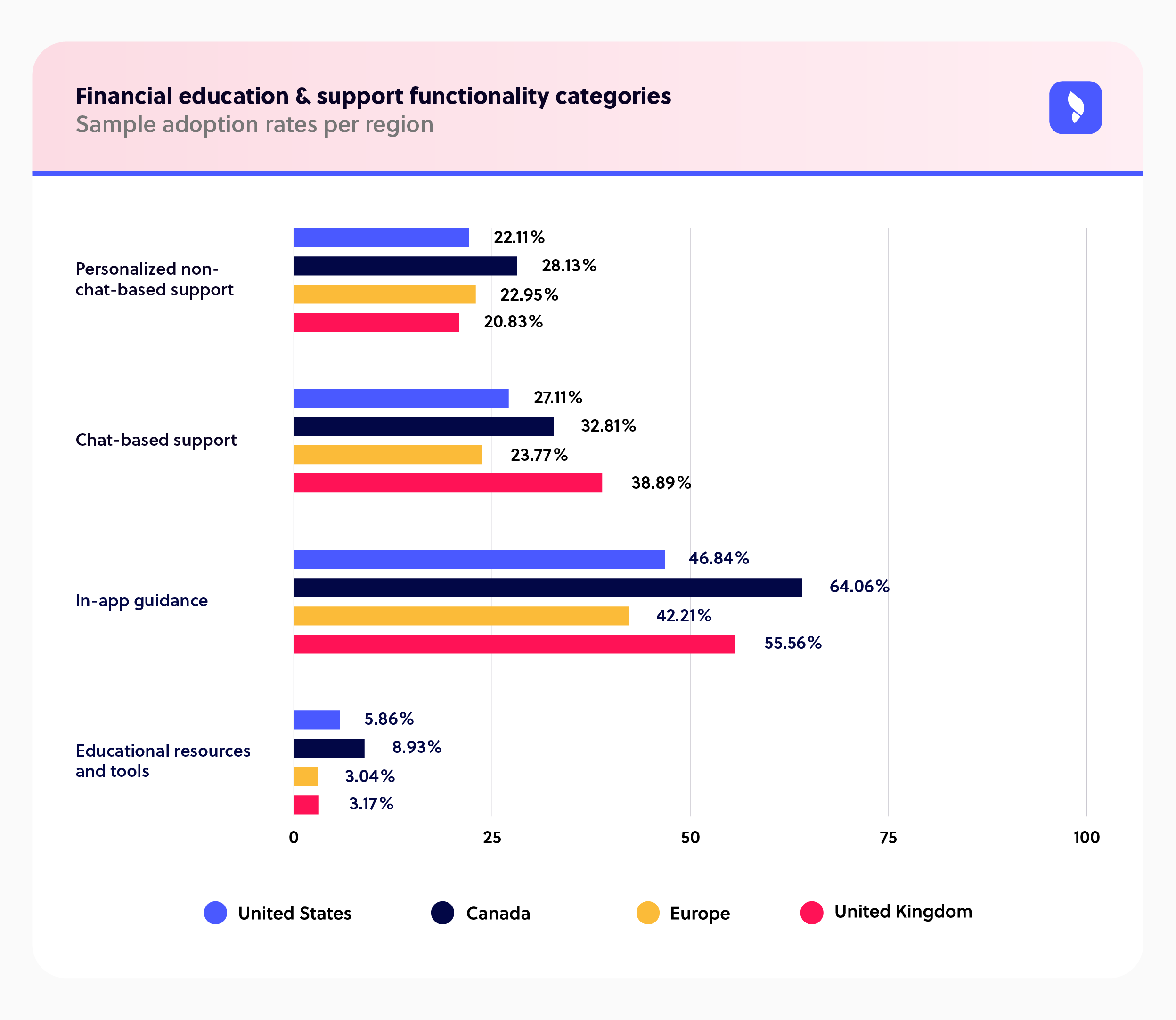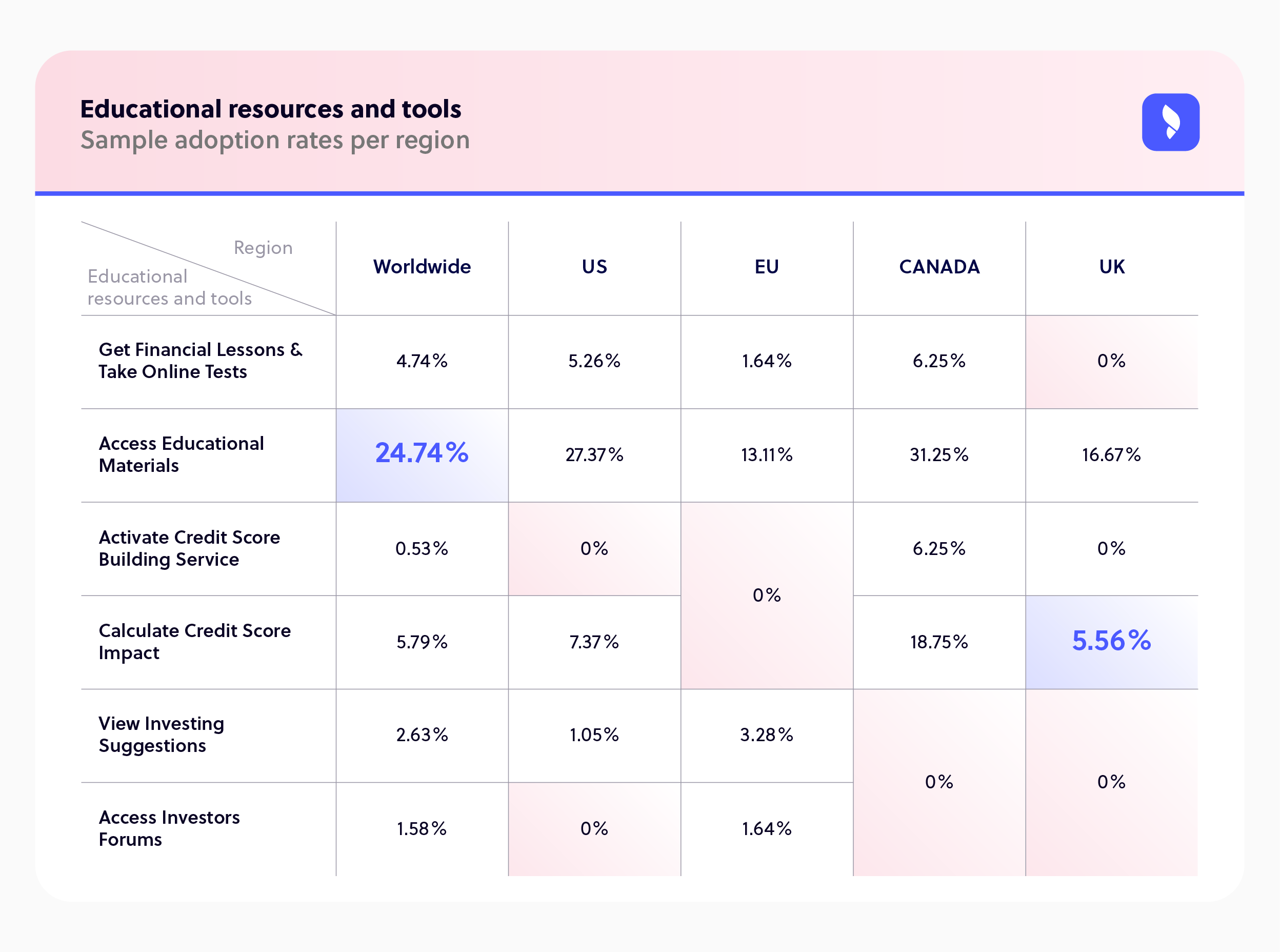Personalized financial education & support: Which markets get it right

Access to personalized educational resources and support is one of the key priorities for banking consumers. 70% of respondents to a Sopra digital banking experience survey said they'd like their bank to give them financial advice, while 78% would be more loyal if they received personalized support.
So what's the current situation in major markets? Which types of educational resources and customer support features are most widely available?
Here's what the latest data from our digital banking research platform FinTech Insights tells us.
The four key feature categories under analysis
For our research to be as thorough as possible, we compiled a data-set of 190 banks, fintechs, and credit unions:
-
95 in the US
-
61 in the EU
-
18 in the UK
-
16 in Canada
Our analysis focused on the firms in our data set's iOS apps.
As the data set was fairly large, FinTech Insights revealed a significant number of financial education and customer support features. For simplicity's sake, we grouped them into four loose categories:
-
Personalized non-chat-based support. These features involve interactions with an agent, otherwise than via live chat, for example co-browsing, in-app messages, or requesting a callback.
-
Chat-based support, where the customer interacts with a chatbot or a live agent via text-based in-app chat or WhatsApp, or with a live agent via video chat.
-
In-app guidance, that is knowledge-bases, support documentation, tutorials, tips and help information the customer can look at to try and solve issues on their own
-
Educational resources and tools, such as articles, videos, podcasts, quizzes, and credit score simulations, that help the customer improve their financial literacy
Help yourself
At 56.18% of the sample overall, in-app guidance, where the customer looks for answers to their issues and tries to solve them on their own, are the most commonly-implemented capabilities.
By contrast, getting help from the bank is considerably more challenging.
Chat-based support, which is the second most commonly implemented category, trails significantly behind in-app guidance, with just 31.58% of the sample offering it.
Only 24.34% offer personalized non-chat-based support via their app. And, at 5.79% — 11 out of 190 — the number of firms offering educational resources and tools is almost negligible.

As the leaders in three out of four categories — personalized non-chat-based support, in-app guidance, and educational resources and tools — Canadian firms are the best of the lot, albeit they still have a lot of work to do in the latter category.

At the other end of the spectrum, EU banks and fintechs are the worst at offering educational resources and tools, though the rest of the regions aren't much better.
UK firms are slightly better at offering chat-based support than the other three markets. But, they lag behind on non-chat-based support, albeit not by much: at 22.11% and 22.95% respectively, the US and EU are virtually tied, while Canadian firms are only marginally better at 28.13%.
How hard is it for a customer to speak to a human?
So, what happens when in-app resources don't solve the customer's problem?
Most firms in our sample direct the user to a chatbot. Overall, 63.68% have one, making it the most common functionality after the functionalities in the in-app guidance category.
Live chat is less common. Overall, 54.74% allow you to chat to an agent. But the results vary by region, with the UK being the market where the functionality is most adopted, and Canada the market where it's least adopted.

When it comes to getting support from a human by non-chat means, the results are also mixed.
Half of Canadian firms enable you to book an appointment with a representative and half of UK firms have in-app messaging capabilities. The majority of the remaining personalized non-chat human support stats, however, are underwhelming.

The state of in-app financial education
The majority of firms that offer educational resources — 24.74% of the overall sample — do so through videos, articles, webinars, and podcasts.
In the UK, the only other educational feature available is the ability to show how credit applications would impact credit score, and only 5.56% of the sample — one firm — offers it.
The other three markets offer alternatives to varying degrees:

Empowered customers are more loyal
There's plenty of research that shows customers are more likely to stick around if they feel a brand understands them and caters to their needs.
At its most basic, the purpose of any business is to solve a problem. In a financial services context, that means helping customers make the most of their money, and promptly addressing any issues they might have.
So why aren't more banks offering educational resources and in-app guidance, and making it as easy as possible to get support?
Our data shows this is an area with potential. As things stand, the bar is low. So, banks that do offer these capabilities could see a positive impact on their performance compared to their competitors.
Want more in-depth analysis about the financial education and support features in your market, and how you can exceed customers' expectations?
Try FinTech Insights FREE
You may also like
February 27, 2025
November 5, 2024
February 7, 2024

Build a digital banking strategy that can't be challenged
Let's show you how FinTech Insights can help you wow your customers, on every login.